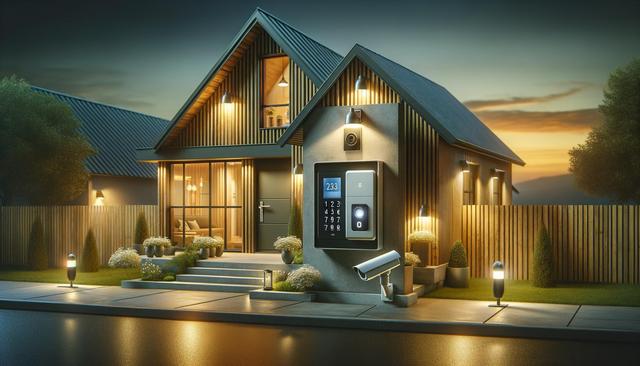
Protecting What Matters: A Comprehensive Guide to Home Security Systems
Understanding the Basics of Home Security Systems
Home security systems are designed to deter intrusions, monitor activity, and alert homeowners and authorities to potential threats. At their core, these systems typically include a combination of sensors, cameras, alarms, and control panels that work together to secure entry points such as doors and windows. Over time, these systems have evolved to include smart technology, allowing for remote monitoring and control via smartphones or other connected devices. This integration of technology has made home security more accessible and adaptable to individual needs.
Security systems can be divided into two main types: monitored and unmonitored. Monitored systems are connected to a professional security company that responds to alerts, while unmonitored systems rely on local alarms and homeowner intervention. Choosing between the two depends on your lifestyle, budget, and desired level of involvement. Both options offer valuable protection but serve different purposes depending on the user’s specific requirements.
Key Components to Consider When Choosing a System
When selecting a home security system, it’s essential to consider the individual components that make up the system. These parts contribute to the overall effectiveness and user experience. Common components include:
- Control panel or hub
- Motion detectors
- Window and door sensors
- Security cameras (indoor and outdoor)
- Glass break sensors
- Alarm sirens
Some systems also offer smoke, carbon monoxide, and flood sensors, which add extra layers of protection. Depending on your home’s layout and the level of risk in your area, you may need a more comprehensive setup. It’s also important to evaluate whether the system can be expanded or customized in the future, as your security needs may evolve.
Wireless systems are becoming increasingly popular due to their ease of installation and flexibility. However, wired systems still offer reliable performance, particularly in larger homes or properties with complex layouts. Carefully comparing these features based on your living situation can help you make a more informed decision.
Smart Technology and Integration
Modern home security systems often come with smart technology features that enhance convenience and control. These systems can be integrated with other smart home devices, such as lighting, thermostats, and door locks, creating a seamless and automated living environment. Some key advantages of smart security systems include:
- Remote monitoring and control via mobile apps
- Real-time alerts and notifications
- Integration with voice assistants
- Cloud storage for video footage
These features allow homeowners to stay connected to their property at all times, even when they’re away. This is especially beneficial for frequent travelers or those who spend extended periods away from home. Additionally, smart security systems often come with user-friendly interfaces that make them accessible for people of varying tech comfort levels.
With the rise of the Internet of Things (IoT), smart home integration is no longer a luxury but an increasingly common expectation. Choosing a system that supports this level of connectivity ensures your home remains secure while adapting to future technological advancements.
Installation Options and Professional Assistance
Another important aspect to consider is how the system will be installed. Some home security systems are designed for easy DIY installation, while others may require professional setup. DIY systems are typically wireless and come with detailed instructions, making them ideal for renters or those looking for a quick solution. On the other hand, professionally installed systems often offer more extensive coverage and come with the added benefit of expert advice.
Professional installation may be preferable for larger homes or if you want to ensure that every component is optimally placed. Installers often conduct a thorough assessment of your property and recommend ideal sensor and camera placements based on potential vulnerabilities. Additionally, having a professional setup reduces the chances of user error, which can compromise the system’s effectiveness.
When choosing between DIY and professional installation, consider factors such as your technical ability, the time you can dedicate to setup, and whether you plan to move in the near future. Some companies also offer hybrid options, where you can install basic components yourself and request professional assistance for more complex features.
Maintaining and Upgrading Your System
Once your home security system is in place, regular maintenance ensures it continues to function properly. This includes checking battery levels, updating software, and testing alarms and sensors periodically. Many systems offer maintenance alerts to notify you when a component needs attention, helping you stay ahead of potential issues.
It’s also important to stay informed about new security technologies and features. As threats evolve, so do the tools to combat them. Upgrading your system over time can include adding additional sensors, integrating with new smart devices, or enhancing camera capabilities. This proactive approach ensures your home remains as secure as possible.
In addition to maintenance, consider creating a household security plan that outlines what to do in case of an emergency. This plan should be shared with all members of the household and include steps for contacting authorities, exiting the home safely, and using the security system effectively. A well-maintained and regularly updated system provides not only security but also confidence in your home’s safety infrastructure.
Conclusion: Choosing the Right Security for Your Home
Home security systems play a vital role in protecting your property, valuables, and loved ones. With a wide range of options available—from basic alarm setups to advanced smart technology integrations—there is a solution to suit nearly every household’s needs. By understanding the components, installation methods, and ongoing maintenance requirements, homeowners can make informed decisions that provide lasting peace of mind.
Investing in a home security system is more than just a precaution; it’s a proactive step toward ensuring safety and comfort. Whether you opt for a DIY setup or professional system, the key is to choose a solution that aligns with your lifestyle, budget, and long-term security goals.


